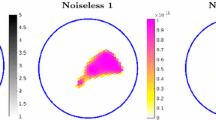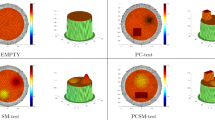Abstract
In electrical tomography, multiple measurements of voltage are taken between electrodes on the boundary of a region with the aim of investigating the electrical conductivity distribution within the region. The relationship between conductivity and voltage is governed by an elliptic partial differential equation derived from Maxwell’s equations. Recent statistical approaches, combining Bayesian methods with Markov chain Monte Carlo (MCMC) algorithms, allow to greater flexibility than classical inverse solution approaches and require only the calculation of voltages from a conductivity distribution. However, solution of this forward problem still requires the use of the Finite Difference Method (FDM) or the Finite Element Method (FEM) and many thousands of forward solutions are needed which strains practical feasibility.
Many tomographic applications involve locating the perimeter of some homogeneous conductivity objects embedded in a homogeneous background. It is possible to exploit this type of structure using the Boundary Element Method (BEM) to provide a computationally efficient alternative forward solution technique. A geometric model is then used to define the region boundary, with priors on boundary smoothness and on the range of feasible conductivity values. This paper investigates the use of a BEM/MCMC approach for electrical resistance tomography (ERT) data. The efficiency of the boundary-element method coupled with the flexibility of the MCMC technique gives a promising new approach to object identification in electrical tomography. Simulated ERT data are used to illustrate the procedures.
Similar content being viewed by others
References
Besag J., Green P.J., Higdon D., and Mengersen K. 1995. Bayesian computation and stochastic systems. Statistical Science 10: 1–41.
Brebbia C.A., Telles J.C.F., and Wrobel L.C. 1984. Boundary Element Techniques: Theory and Applications. New York, USA, Springer-Verlag.
Cheney M., Isaacson D., and Newell J.C. 1999. Electrical impedance tomography. SIAM Review 41: 85–101.
Duraiswami R., Chahine G.L., and Sarkar K. 1997. Boundary element techniques for efficient 2-D and 3-D electrical impedance tomography. Chem. Eng. Sci. 52: 2185–2196.
Garabedian P.R. 1964. Partial Differential Equations. London, UK, AMS Chelsea Publishing.
Hanselman D. and Littlefield, D. 2001. Mastering Matlab 6—A Comprehensive Tutorial and Reference. New Jersey, USA, Prentice and Hall.
Hoyle B. 2004. Industrial process tomography progress. In: Proceedings of the 3rd International Symposium on Process Tomography in Poland, Lodz, Poland, pp. 9.
Ider Y.Z., Gencer N.G., Atalar E., and Tosun H. 2004. Electrical impedance tomography of translationally uniform cylindrical objects with general cross-sectional boundaries. IEEE Trans. Medical Imaging 9: 49–59.
Jaswon M.A. and Symm G.T. 1977. Integral Equation Methods in Potential Theory and Electrostatics. London, Academic Press.
Katsikadelis J.T. 2002. Boundary Elements: Theory and Applications. Elsevier Science.
Liu J.S. 2001. Monte Carlo Strategies in Scientific Computing. Berlin, Springer-Verlag.
Metropolis N., Rosenbluth A.W., Rosenbluth M.N., Teller, A.H., and Teller E. 1953. Equations of state calculations by fast computing machine. J. Chem. Phys. (1953) 21: 1087–1091.
Spiegel M.R. 1974. Theory and problems of vector analysis. Schaum’s Outline Series. New York, USA, McGraw–Hill book company.
Somersalo E., Cheney M., and Cheney D. 1992. Existence and uniqueness for electrode models fore electric computed tomography. SIAM J. Appl. Math. 52: 1023–40.
Stitt E.H. and James K. 2003. Process tomography and particle tracking: Research tool and commercial diagnostic tool. In: Proceedings of the 3rd World Congress on Industrial Process Tomography, Banff, Canada.
Vilhunen T., Kaipio J.P., Vauhkonen P.J., Savolainen T., and Vauhkonen M. 2002. Simultaneous reconstruction of electrode contact impedances and internal electrical properties: I. Theory. Meas. Sci. Technol. 13: 1848–1854.
West R.M., Aykroyd R.G., Meng S., and Williams R.A. 2004. Markov Chain Monte Carlo techniques and spatial-temporal modelling for medical EIT. Physiological Measurements 25: 181–194.
West R.M., Meng S., Aykroyd R.G., and Williams R.A. 2005. Spatial-temporal modelling for EIT of a mixing process. Review of Scientific Instruments 76: 3703/1–10.
Wrobel L.C. 2002. The Boundary-Element Method: volume 1, Applications in Thermo-Fluids and Acoustics. John Wiley publishers.
Author information
Authors and Affiliations
Corresponding author
Rights and permissions
About this article
Cite this article
Aykroyd, R.G., Cattle, B.A. A flexible statistical and efficient computational approach to object location applied to electrical tomography. Stat Comput 16, 363–375 (2006). https://doi.org/10.1007/s11222-006-9619-x
Received:
Accepted:
Issue Date:
DOI: https://doi.org/10.1007/s11222-006-9619-x




